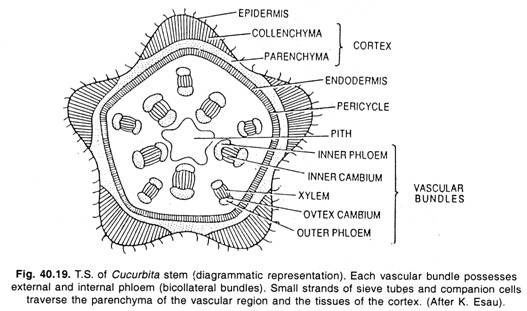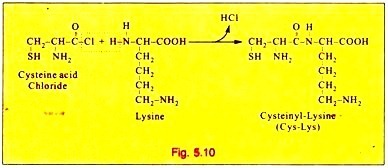The following points highlight the top three ways for separating amino acids from peptides. The ways are: 1. Paper Chromatography 2. Electrophoresis 3. Ion Exchange Chromatography.
Separating Amino Acids from Peptides: Way # 1.
Paper Chromatography:
a. A small volume (about 0.005 ml containing about 0.01 mg) of amino acid is applied at a marked point 5 cm from the end of filter paper strip.
b. The filter paper strip is suspended in a sealed cylindrical jar or cabinet.
c. One end of the strip is dipped into a solvent consisting of water, an acid or base, an organic substance such as n-butyl alcohol.
d. The solvent is placed in a trough from which the paper strip hangs (descending paper chromatography) or the strip may be suspended from the top of the jar and dipped into a trough at the bottom of the jar ascending paper chromatography).
e. Strips are removed when the solvent migrates the marked distance and dried.
f. Then the strips are sprayed with 0.5% ninhydrin in acetone and heated for a few minutes at 80 – 100°C.
g. Purple spots will indicate the presence of amino acids.
h. The amino acids are identified by the Rf value which is determined as follows:
Rf = Distance travelled by an amino acid from the marked point of application/Distance travelled by the solvent form the marked point of application
Thin Layer Chromatography:
Thin layer chromatography may be employed in place of paper chromatography.
a. The absorbents (e.g., cellulose powder, alumina, a cellulose ion exchange resin, sephadex) are spread as a slurry on 8 x 18 inch glass plates.
b. The plates are dried and used like paper strips of paper chromatography.
c. The advantage in this is in the choice of absorbents and in the rapidity of separation. Amino acid mixtures require 3 hours for separation instead of 18 hours.
d. Lipids including sterols are rapidly and clearly separated.
Separating Amino Acids from Peptides: Way # 2.
Electrophoresis:
a. Amino acid mixtures are applied at the centre of the paper or thin layers of powdered cellulose.
b. This is then moistened with buffer of an appropriate pH connected to buffer reservoirs by paper wicks and covered with a glass plate to reduce evaporative loss of buffer during passage of the current.
c. The current is applied with 2,000 – 5,000 volts for 0.5 – 2 hours. The molecules at the net positive charge at the selected pH move toward the cathode and those with a net negative charge toward the anode.
d. The electro-gram (paper or thin layers of powdered cellulose) is dried and treated with ninhydrin to see the separated amino acids.
e. The amino acids are separated readily on the basis of their difference in molecular weight.
f. pH 3.5 is better for the separation of the peptides formed from the enzymic digestion of a protein.
Separating Amino Acids from Peptides: Way # 3.
Ion Exchange Chromatography:
a. Analysis of amino acid residues after hydrolysis of a polypeptide involves ion exchange chromatography.
b. In this procedure, a short and long column that contains the Na+ form of a Glutathione sulfonated polystyrene resin.
c. When acid hydrolysate at pH2 is applied to the columns, the amino acids bind via cation exchange with Na+.
d. The columns are then eluted with sodium citrate under the conditions of pH and temperature.
e. Eluted material is reacted with ninhydrin reagent and colour densities are monitored in a flow through colorimeter.
f. Datas are displayed on a cathode ray tube with computer linked integration of peak areas.

